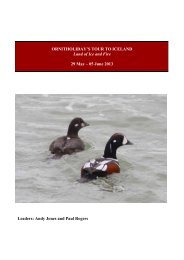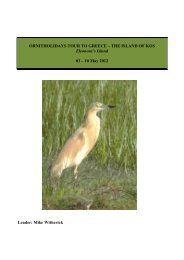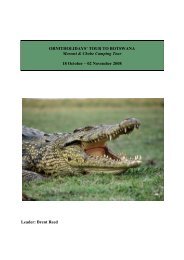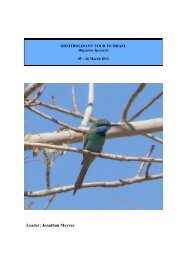Download 2014 Brochure (.pdf) - Ornitholidays
Download 2014 Brochure (.pdf) - Ornitholidays
Download 2014 Brochure (.pdf) - Ornitholidays
Create successful ePaper yourself
Turn your PDF publications into a flip-book with our unique Google optimized e-Paper software.
PA P U A N E W G U I N E A<br />
Papua New Guinea<br />
Birds of Paradise<br />
Wednesday 17 September – Friday 03 October <strong>2014</strong><br />
Leaders: Simon Boyes and local guides<br />
<strong>2014</strong> Cost £7,999 single room supplement £900<br />
Karawari Lodge<br />
Ambua Lodge<br />
PAPUA NEW GUINEA<br />
Kumu Lodge<br />
Port Moresby<br />
or many people, New Guinea represents the ultimate birding goal. Certainly Sir David Attenborough regards the country as ‘the greatest<br />
F unclaimed prize in ornithological filming.’ His classic programme about the splendours of the birds of paradise and bowerbirds has created a<br />
widespread public interest in experiencing New Guinea at first hand. Until recently, the island’s remoteness and lack of tourist infrastructure prevented<br />
this dream from becoming reality. Now, with the help of some well-located lodges, we can explore the best Papuan habitats and their unique birdlife<br />
in comfort and safety. We will divide our time between one lowland lodge (Karawari) and two highland lodges (Kumul Lodge and Ambua Lodge) before<br />
finishing our tour in the capital Port Moresby. This should give us a wonderful opportunity to watch many species of birds of paradise (which possess<br />
some of the world’s most exotic plumages and displays), as well as a wide variety of pigeons and fruit-doves, parrots, cuckoo-shrikes, kingfishers and<br />
bowerbirds. Less familiar groups include fairy-wrens, whistlers, berrypeckers, butcherbirds and honeyeaters. We will also be able to observe some of<br />
Papua’s colourful peoples, with their distinctive tribal dress and customs. There is an option of breaking the outward or return journeys in Singapore<br />
for those who wish. This will be <strong>Ornitholidays</strong>’ third tour to Papua New Guinea<br />
ITINERARY<br />
Days 1 & 2<br />
We leave London Heathrow on a scheduled<br />
flight to Singapore, arriving the next day. We<br />
then catch the connecting flight to Port Moresby.<br />
Day 3<br />
Arriving in the morning, we are welcomed by our<br />
hosts and transferred to our hotel. We have time<br />
to freshen up, relax and have lunch. In the<br />
afternoon we begin with a gentle introduction to<br />
the birds of PNG with a visit to the grounds of the<br />
Pacific Adventists’ University, where the ponds<br />
attract a good selection of waterbirds. In<br />
particular, we will look for Blue-winged<br />
Kookaburra, Rufous Night Heron, Black Bittern,<br />
Wandering, Plumed and Spotted Whistlingducks,<br />
Comb-crested Jacana, Brown Oriole,<br />
Fawn-breasted Bowerbird, Rufous-banded<br />
Honeyeater, Black-backed Butcherbird,<br />
Torresian Pied Imperial-Pigeon, Orangebreasted<br />
Fruit-Dove, Singing Starling and<br />
Grey-headed Munia.<br />
Days 4 to 6<br />
The next morning we transfer to the airport and<br />
take a short domestic flight to Mount Hagen, in<br />
the Central Highlands. From here, a 90 minute<br />
drive brings us to Kumul Lodge, set at 2,800m<br />
just over the border in Enga Province, where we<br />
stay for three nights. The accommodation is<br />
simple and rustic, but you will love the setting –<br />
as you can relax in a comfortable chair and<br />
watch the well-stocked bird table laden with<br />
fruits and have your first close-up experience of<br />
Birds of Paradise! Notable visitors to the garden<br />
feeder are Brown Sicklebill and Ribbon-tailed<br />
Astrapia, Brehm’s Tiger-Parrot, and with luck the<br />
shy Bronze Ground Dove and Archbold’s<br />
Bowerbird. The photographic opportunities are<br />
wonderful. We also hope for Plum-faced and<br />
Papuan Lorikeets, Regent, Brown-backed and<br />
Rufous-naped Whistlers, White-winged Robin<br />
and Mountain Firetail. We can walk the trails<br />
below the lodge and look for Lesser Melampitta,<br />
as well as Blue-capped Ifrita, a bird with a<br />
poisonous plumage. Excursions we can take<br />
from the lodge may enable us to find<br />
Magnificent Bird of Paradise, Torrent Flycatcher<br />
and with luck Torrent-lark.<br />
Days 7 to 9<br />
This morning we say goodbye to the staff at<br />
Kumul and make the return journey to Mt Hagen<br />
where we catch a charter flight to Karawari<br />
Airstrip over impressive mountain scenery. We<br />
drop down into the lowlands of the Sepik Valley.<br />
The journey from airstrip to lodge is by boat, the<br />
only practical transport in such an isolated<br />
region. Karawari Lodge is perched on a ridge,<br />
with spectacular views over endless tropical<br />
forest. It is built in the style of a traditional spirit<br />
house, decorated with local artefacts and boldly<br />
carved furniture. Here we can watch from the<br />
balcony for species such as Blyth’s Hornbill and<br />
Glossy-mantled Manucode. The gardens attract<br />
Orange-bellied and Coroneted Fruit Doves,<br />
Double-eyed Fig-Parrot, Variable Pitohui, Streakheaded<br />
Honeyeater and Black Sunbird (to name<br />
a few). Much of the birding will be done from<br />
stable boats which can be tied to the bank to<br />
allow scope use. In this way we will look for King<br />
Raggiana Bird of Paradise<br />
88<br />
For a previous tour report or further information please call: 01794 519445








